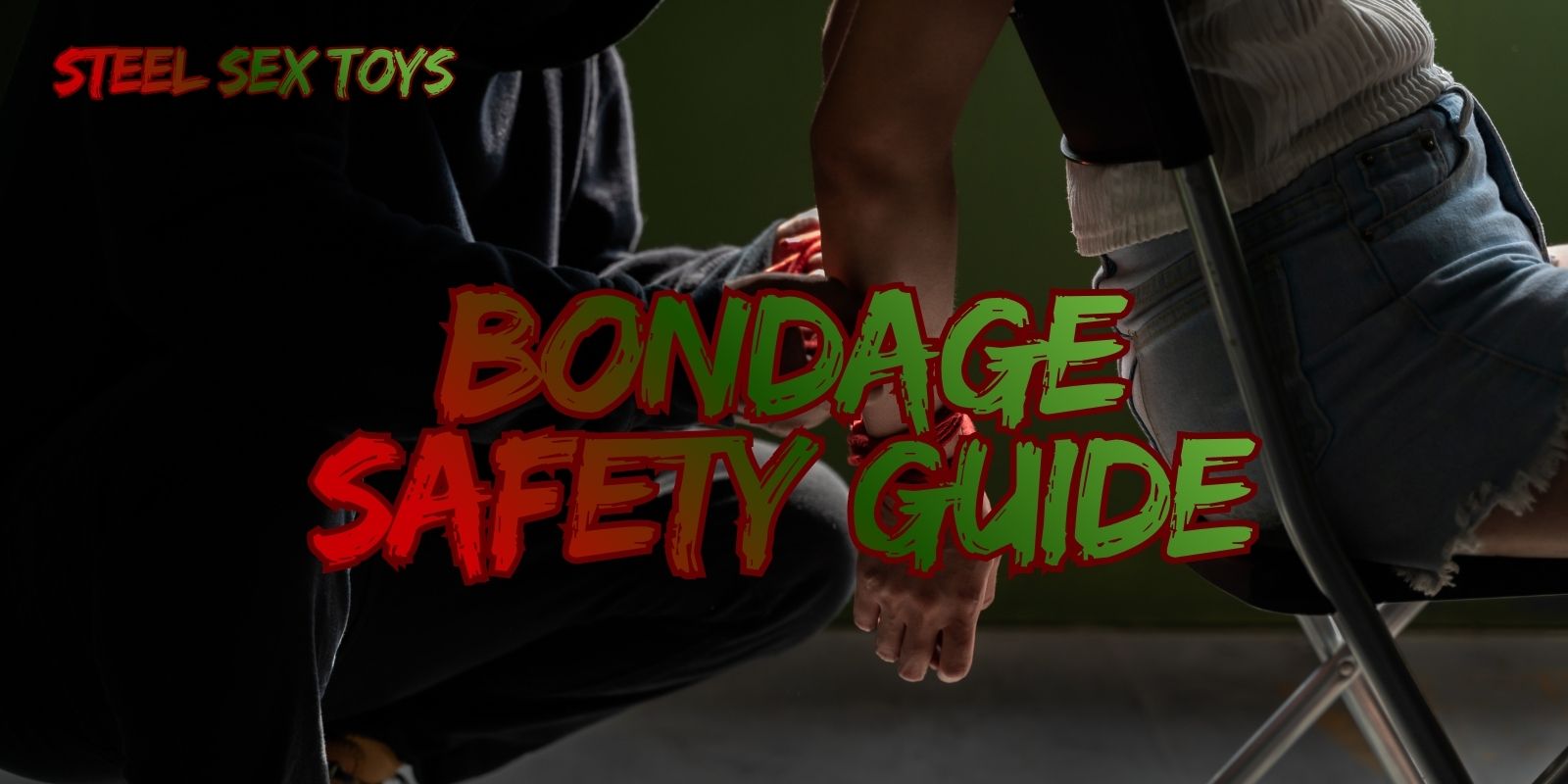Bondage Safety Guide: Consensual & Satisfying BDSM Play
Bondage Safety Guide: Bondage can be exciting and deeply intimate — but safety must always come first. With the right communication, consent, and preparation, BDSM becomes a trust-filled experience that’s both pleasurable and risk-aware.
A safe BDSM experience relies on trust, consent, and communication. Learn essential bondage safety practices to enjoy intense pleasure while protecting comfort, wellbeing, and emotional connection.
Table of Contents – Bondage Safety Guide
- Bondage Safety: Why It Matters
- 1. Communication Comes First
- 2. Comfort & Listening to the Body
- 3. Safe Handling of Restraints
- 4. Knowledge Before Play
- 5. Move at Your Own Pace
- 6. Consent in BDSM play
- 7. Know & Define Your Limits
- 8. Setting the Mood Safely
- 9. Choose the Right Space
- 10. Aftercare & Emotional Safety
- Key Takeaways
- FAQ
- Your Safe Pleasure Journey

Bondage Safety: Why It Matters
Bondage Safety Guide: – Bondage can be thrilling, empowering, and intensely intimate. But without proper understanding and attention to safety, it can result in discomfort or injury. Metal toys, restraints, ropes, and powerful sensations must always be handled with care and respect for the partner receiving them.
Every BDSM scene should be rooted in mutual trust. When partners share fantasies and pleasure goals openly, they reduce anxiety and ensure that everyone feels seen, valued, and protected. The emotional bond deepens even more when safety is prioritized.
Before diving into kink adventures, explore expert insights like sound safety guides and best practices for the toys being used. Preparation brings peace of mind — which leads to more intense and satisfying play.
1. Communication Comes First – Bondage Safety Guide
Before any bondage scene begins, every person involved must understand what will happen and what the boundaries are. This ensures that the submissive feels comfortable, protected, and respected throughout the experience. Safe words and signals must also be clearly defined.
Some couples create simple BDSM contracts — agreements that detail limits, desires, and activities that are off-the-table entirely. These help maintain clarity and protect both partners, especially in scenes where communication may become physically restricted.
When voice is not available due to restraints, gags, or masks, create alternate signals such as foot tapping, hand squeezing, blinking, or controlled muscle movements. These small actions can instantly communicate the need to pause or stop.
2. Comfort & Listening to the Body
If the submissive feels internal or external discomfort, the scene must pause or stop immediately. Pain can be erotic — but only when it is intentional, desired, and controlled by both partners through continuous feedback. Never push through discomfort silently.
The dominant should regularly check in, especially during intense or longer sessions. Even a simple “Are you okay?” reassures the submissive that their wellbeing is the top priority. This builds trust and heightens intimacy.
Always place health first — even if the partner insists they are fine, discomfort that lasts more than a few minutes is a sign to stop, rest, and reassess before continuing.
3. Safe Handling of Restraints
Handcuffs, rope, leather cuffs, and steel bondage tools should always fit securely but never restrict circulation. Numbness, tingling, or discoloration are signs that restraints are too tight and must be adjusted immediately.
Keep a pair of bondage safety scissors or shears within reach at all times. They ensure you can end a scene instantly if circulation is compromised or panic sets in. For locks, always test keys before play to prevent accidental entrapment.
Bondage should feel secure — but never unsafe. The goal is exhilarating surrender, not physical risk or injury.
4. Knowledge Before Play
Before using metal gadgets, vibrators, hooks, or electro-stim devices, understand their correct use, pressure points, and lubrication requirements. Proper preparation can prevent painful or harmful accidents during the excitement of play.
Anal hooks or vaginal hooks should always be well-lubricated and aligned with the body’s natural angle before insertion. Sharp movement or surprise impact can cause tissue tears or painful spasms if used carelessly.
If experimenting with something new, talk about it first. In BDSM, informed anticipation is part of the pleasure — not something to skip.
5. Move at Your Own Pace
Do not attempt to recreate intense scenes you may have seen through films or pornography. What looks easy on-screen may involve trained experts, advanced safety crews, or visual effects. Real-life safety comes first.
A slow progression helps develop trust and excitement gradually — and confidence grows stronger when exploration happens without pressure. Bondage Safety Guide – There’s no rush to reach the most extreme fantasies immediately.
BDSM is an evolving journey. Pace allows your body and desires to align with your readiness — and to expand comfortably over time.
6. Consent in BDSM Play – Bondage Safety Guide
Consent is the foundation of ethical kink. Even if a submissive previously agreed to something, if they become uncomfortable during the session, the dominant must check in and stop immediately if requested. Safety is dynamic — not a one-time agreement.
Safe words like “Red” or playful alternatives such as “Helicopter” must end all activity instantly. A shared protocol permits intense play without crossing emotional or physical limits unintentionally.
The strongest power dynamic is built on mutual respect — and knowing that either partner can pause or stop at any moment.
7. Know & Define Your Limits
Each person has unique limits based on comfort levels, physical concerns, beliefs, and emotional readiness. Limits protect everyone involved and ensure the play remains satisfying — not overwhelming. Partners must respect boundaries at all times.
Soft limits are boundaries that may be explored later as trust deepens. Hard limits are strict, non-negotiable lines — never to be crossed for any reason. Understanding the difference is essential for safe play.
Many couples use BDSM checklists to discuss interests and boundaries in advance. Honest clarity ensures that every experience remains consensual, comfortable, and exciting.
8. Setting the Mood Safely – Bondage Safety Guide
BDSM is a multisensory experience. The environment you create can intensify pleasure and roleplay fantasy beautifully. Adjusting lighting can add mystery while still keeping visibility safe enough to move and control the scene responsibly.
Toys like masks, gags, and blindfolds restrict sensory input to heighten attention on each touch and sound. Bondage Safety Guide – Restraints may remove movement, strengthening the dominance–submission dynamic and raising anticipation.
Music and themed outfits also elevate immersion. Sound energizes the room, while clothing fuels character roles. Consider what stimulates both partners mentally — that’s where deeper erotic chemistry occurs.
9. Choose the Right Space
A safe play space means room to move freely without tripping hazards or sharp edges nearby. Ensure that furniture and surfaces support the scene — whether using a bed for cushion or the open floor for control and stability.
Specialized bondage furniture like the St. Andrew’s Cross or racks may be available in BDSM dungeons. These environments include equipment designed for secure restraint and accessible positioning.
Preparation before the scene lets partners stay fully immersed without interruptions. Every item needed — toys, tools, cleaning supplies — should be ready before play begins.
10. Aftercare & Emotional Safety
Aftercare helps partners transition from the heightened intensity of the scene back to emotional calm and physical comfort. This includes eating, hydrating, resting, or simply being held while feelings settle and bodies recover.
After strong BDSM play, dominant and submissive roles shift back to equals who care for each other. Ask questions, reassure, and share what you enjoyed. These conversations deepen trust and help improve future sessions.
Aftercare may also include tending to minor marks or soreness with gentle cleaning or first aid resources like guidance from the Red Cross basic first aid. Nurturing each other is what turns BDSM from fun — into bonding.
Key Takeaways
- Consent, trust, and communication are mandatory for every BDSM experience.
- Checking comfort levels throughout play prevents physical and emotional harm.
- Restraints must never restrict circulation — keep safety cutters nearby.
- Knowledge and preparation increase pleasure and reduce risk.
- Aftercare is essential for emotional connection and recovery.
FAQ – Bondage Safety Guide
Do you need a safe word in every bondage scene?
Yes. Safe words ensure all participants can stop play immediately if discomfort or danger develops — even when communication is restricted.
Can beginners start BDSM without experience?
Absolutely, but start slow. Learn safety basics, discuss boundaries, and use beginner-friendly gear before trying intense activities.
Are metal BDSM toys safe?
Yes — when used correctly, with lubrication and proper knowledge of anatomy and safe handling techniques.
Is bondage still safe if the submissive stays silent?
Only if a non-verbal safety signal system is agreed in advance. Silence must never be mistaken for consent.
What should be included in aftercare?
Physical comfort, hydration, reassurance, emotional debriefing, and cleaning up together all reinforce connection and recovery.
Bondage as Trust: Your Safe Pleasure Journey
Bondage Safety Guide – When approached with consent, knowledge, and communication, bondage becomes a celebration of trust and shared desire. Safety does not limit pleasure — it amplifies it, allowing both partners to dive deeper into vulnerability, passion, and erotic exploration.
Take your time, learn your limits, and protect the bond that makes BDSM meaningful. When everyone involved feels safe and empowered, pleasure becomes limitless and unforgettable.




You must be logged in to post a comment.